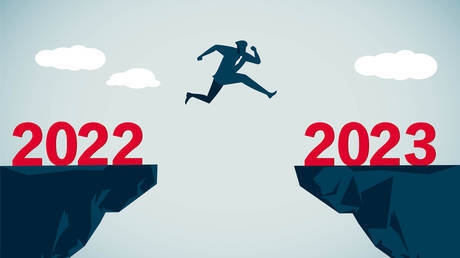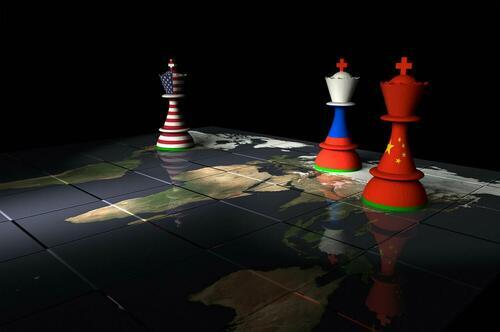Steve Bull's Blog, page 143
January 9, 2023
Who Will Save Us From Ourselves?
We have the capacity to learn from previous civilization’s errors–rising inequality, hubris, over-reach, decay of production and trade, parasitic elites, and so on–yet we go right ahead and repeat those same errors.
After listening to my explanation of the many cycles human civilizations track first to glory and then to decay, podcast host Tommy Carrigan asked a key question: why don’t we stop ourselves from self-destructing? Tommy and I had a free-range conversation on this and related topics (plus a lot of laughs) that you can listen to here: UFOs & Cycles of Humanity (1:36 hrs)
We have the capacity to learn from previous civilization’s errors–rising inequality, hubris, over-reach, decay of production and trade, parasitic elites, and so on–yet we go right ahead and repeat those same errors.
What explains our inability to learn from history and take corrective actions by maintaining the dynamics of adaptive advances? (Transparent governance, the sharing of knowledge, incentivizing trade and enterprise, competition, stable money, rule of law / fairness, social mobility and limits on elites’ plundering / exploitation.)
Why do we allow the decay, over-reach, greed, hubris, institutional sclerosis and parasitic elites that lead to collapse gain the upper hand time and again? Why do we not act on what can be learned from history?
For those of us steeped in science fiction and the study of AI, this question inevitably leads to discussions of the potential immutability of historic cycles (Asimov’s Foundation Trilogy, which posited that cycles could not be annulled but the decay/collapse phase could be reduced in duration), the deus ex machina of contact with extraterrestrial civilizations and the potential of super-intelligent AI to save us from ourselves.

…click on the above link to read the rest…
BlackRock says we’re all doomed. It’s being optimistic
The world’s largest asset manager has forecast systemic economic chaos. The reality is even worse

BlackRock predicts a lasting fall in living standards for the many, alongside huge profits for the few
| Maureen McLean/Alamy Live News
The working assumption, for governments and central banks across the world, is that at some point soon everything will get back to ‘normal’ – our economies will return to either pre-pandemic or, sometimes, even pre-2008 crash levels.
These beliefs are reinforced by media economics commentary and across political parties.
But what if they’re wrong? The world’s largest asset manager, overseeing $10trn in assets across the globe, thinks we are, instead, entering a period of increased risk and uncertainty, defined by unavoidable recession and much higher inflation.
BlackRock – a well-connected, influential and hugely profitable pillar of global capitalism – made the predictions in its ‘2023 Global Investment Outlook’ report.
It states: “The Great Moderation, the four-decade period of largely stable activity and inflation, is behind us.”
Instead, BlackRock forecasts a new regime with a “brutal trade-off” – falling living standards for the many becoming profits for the few.
This reality, of a world undergoing fundamental transformations and disrupting our settled modes of existence, has so far barely entered the economic mainstream.
For BlackRock to break with this consensus might, potentially, be one of the first signs of a broader shift in how major institutions in the Western economies view the world.
Systemic chaos
Annual food inflation in the UK rose to 13.3% – an all-time high – last month, according to trade body the British Retail Consortium, ahead of the official government figures out later this month.
…click on the above link to read the rest…
Why BRI is back with a bang in 2023
 Photo Credit: The Cradle
Photo Credit: The CradleThe year 2022 ended with a Zoom call to end all Zoom calls: Presidents Vladimir Putin and Xi Jinping discussing all aspects of the Russia-China strategic partnership in an exclusive video call.
Putin told Xi how “Russia and China managed to ensure record high growth rates of mutual trade,” meaning “we will be able to reach our target of $200 billion by 2024 ahead of schedule.”
On their coordination to “form a just world order based on international law,” Putin emphasized how “we share the same views on the causes, course, and logic of the ongoing transformation of the global geopolitical landscape.”
Facing “unprecedented pressure and provocations from the west,” Putin noted how Russia-China are not only defending their own interests “but also all those who stand for a truly democratic world order and the right of countries to freely determine their own destiny.”
Earlier, Xi had announced that Beijing will hold the 3rd Belt and Road Forum in 2023. This has been confirmed, off the record, by diplomatic sources. The forum was initially designed to be bi-annual, first held in 2017 and then 2019. 2021 didn’t happen because of Covid-19.
The return of the forum signals not only a renewed drive but an extremely significant landmark as the Belt and Road Initiative (BRI), launched in Astana and then Jakarta in 2013, will be celebrating its 10th anniversary.
BRI version 2.0
That set the tone for 2023 across the whole geopolitical and geoeconomic spectrum. In parallel to its geoconomic breadth and reach, BRI has been conceived as China’s overarching foreign policy concept up to the mid-century. Now it’s time to tweak things…
…click on the above link to read the rest…
‘Silence of the Ecomodernists’ & ‘Fusion Confusion’
January 8, 2023
Escobar: Bye Bye 1991-2022
The hard work starts now. Welcome to the New Great Game on crack…
2023 starts with collective NATO in Absolutely Freak Out Mode as Russian Defense Minister Shoigu announces that Russian Navy frigate Admiral Gorshkov is now on tour – complete with a set of Mr. Zircon’s hypersonic business cards.
The business tour will encompass the Atlantic and the Indian Ocean, and of course include the Mediterranean, the Roman Empire’s former Mare Nostrum. Mr. Zircon on the prowl has absolutely nothing to do with the war in Ukraine: it’s a sign of what happens next when it comes to frying much bigger fishes than a bunch of Kiev psychos.
The end of 2022 did seal the frying of the Big Ukraine Negotiation Fish. It has now been served on a hot plate – and fully digested. Moscow has made it painfully clear there’s no reason whatsoever to trust the “non-agreement capable” declining superpower.
So even taxi drivers in Dacca are now betting on when the much- vaunted “winter offensive” starts, and how far will it go. General Armageddon’s path ahead is clear: all-out demilitarization and de-electrification on steroids, complete with grinding up masses of Ukrainians at the lowest possible cost to the Russian Armed Forces in Donbass until Kiev psychos beg for mercy. Or not.
Another big fried fish on a hot plate at the end of 2022 was the 2014 Minsk Agreement. The cook was no other than former chancellor Merkel (“an attempt to buy time for Ukraine”). Implied is the not exactly smokin’ gun: the strategy of the Straussian/neo-con and neoliberal-con combo in charge of U.S. foreign policy, from the beginning, was to unleash a Forever War, by proxy, against Russia.
…click on the above link to read the rest…
Turkiye’s Erdogan Flips Syria on its Head

While we are all, rightfully, worried about what’s going on in Ukraine, those sneaky Russians are shoring up their situation on the south shores of the Black Sea and Eastern Mediterranean.
As reported last week the meeting between Russia, Turkiye, and Syria took place between their Defense Ministers where they all described the talks as ‘constructive’ towards solving multiple outstanding issues like refugees and the backing of radicals.
This meeting was put in motion by Turkish President Recep Tayyip Erdogan as the Moscow Times article notes:
In November, Erdogan said a meeting with Syrian leader Bashar al-Assad was a possibility, after cutting diplomatic ties with Damascus throughout the 11-year conflict.
In mid-December, he indicated that he could meet with Assad after the two countries’ defense and foreign ministers meet.
“We want to take a step as Syria, Turkey and Russia,” [emphasis mine] he said at the time.
The issues discussed are especially important for Erdogan as the protracted war is sapping his popularity at home in the face of an ongoing pull out of western capital from Turkey that has seen the lira go through what can only be described as a hyperinflation since 2018.
With elections on the horizon and Erdogan’s position tenuous for the first time in his political career, moves need to be made now to improve things. Allowing the millions of Syrian refugees the opportunity to go home would be a big win for Erdogan politically.
This is also a good use of Sergei Shoigu, the Russian Defense Minister, since he’s not in charge of the operation in Ukraine and hasn’t been since October, with good reason.
Shoigu, I’m sure, has been preparing for this meeting for months, laying the groundwork for talks between Turkiye and Syria that are long overdue.
…click on the above link to read the rest…
Finding a place to take a stand
Mapping regions bio and cultural
 David McCloskey’s recently completed mapping of regions around the Salish Sea.
David McCloskey’s recently completed mapping of regions around the Salish Sea.Regions in a time of breakdown
The Raven is increasingly focusing on the concept of regionalism, the idea that, as urbanist Lewis Mumford put forward many years ago, there is a “regional framework of civilization.”
Mumford’s thinking, to which The Raven devoted a series beginning here, is that regions are the basic units through which the world is connected. He wrote, “Real interests, real functions, real intercourse flow across (national boundaries): while the effective organs of concentration are not national states . . . but the regional city and the region.”
This is more than an abstract discussion. In focusing on the regional dimension, I am pointing in a direction to cope with and eventually rebuild from a time of national and global breakdown. As the tagline of this web journal states, to plot a path for “living beyond empire.”
Breakdown is increasingly in the foreground. Conflicts and divisions are growing within nations and between them. Supply chains are snapping. Climate chaos is intensifying. National and global institutions are increasingly incapable of responding to the interwoven crises facing us. In fact, national and global elites continue to pursue models through which they have gained power and wealth, even as the destructive consequences of those models escalate. Whether it is continuing to expand the production of fossil fuels and arms, or perpetuating a profit-oriented capitalism heedless of social and ecological impacts.
Elites insulated in their bubbles will be the last ones to feel the consequences, which is why they will continue to prolong them. As historian Arnold Toynbee determined from his study of civilizations, this is the dynamic that causes civilizations to collapse.
…click on the above link to read the rest…
In 2022, the world as we knew it ended. Decades of conflict lie ahead

The ‘end of history’ has concluded and the world has returned to conflicts between ‘great powers’. Let’s hope it doesn’t turn nuclear By Ivan Timofeev, Valdai Club Programme Director & one of Russia’s leading foreign policy experts.© Getty Images / erhui1979
In 1989, the ‘short 20th century’ concluded with the ‘end of history’ – the victory of the Western capitalist world over the Soviet socialist project. At that time, there was not a single country, or community, left in the world which offered a realistic alternative to the US-led view of the organization of the economy, society, and the political system.
The Soviet bloc dissolved itself. A large part of it quickly integrated into NATO and the European Union. Other major world players had begun to integrate organically into the Western-centered world system long before the end of the Cold War. China retained a high level of sovereignty in terms of its domestic order, but quickly moved into a capitalist economy, actively trading with the US, EU, and the rest of the world.
Beijing, meanwhile, shied away from promoting the socialist project abroad. India had avoided claiming global projects of its own, although it has, to this day, also maintained a high level of identity in its political system and has so far shied away from joining blocs and alliances. Other major players also remained within the rules of the ‘liberal world order’ game, avoiding attempts to challenge it.
Individual rebels, such as Iran and North Korea, did not pose much of a threat, although they raised concerns with their stubborn resistance, persistent promotion of nuclear programs, successful adaptation to sanctions, and for the most part, any potential military attack was ruled out because of its high cost. For a brief period, it seemed that the global challenge might come from radical Islamism. But it could not shake the existing order either.
…click on the above link to read the rest…
January 7, 2023
The Human Eco-predicament: Overshoot and the Population Conundrum
and the Population Conundrum
This article was originally published by
Vienna Yearbook of Population Research 2023, Vol. 21, pp. 1–19
Abstract: The human enterprise is in overshoot, depleting essential ecosystems faster than they can regenerate and polluting the ecosphere beyond nature’s assimilative capacity. Overshoot is a meta-problem that is the cause of most symptoms of eco-crisis, including climate change, landscape degradation and biodiversity loss. The proximate driver of overshoot is excessive energy and material ‘throughput’ to serve the global economy. Both rising incomes (consumption) and population growth contribute to the growing human eco-footprint, but increasing throughput due to population growth is the larger factor at the margin. (Egregious and widening inequality is a separate socio-political problem.) Mainstream approaches to alleviating various symptoms of overshoot merely reinforce the status quo. This is counter-productive, as overshoot is ultimately a terminal condition. The continuity of civilisation will require a cooperative, planned contraction of both the material economy and human populations, beginning with a personal to civilisational transformation of the fundamental values, beliefs, assumptions and attitudes underpinning neoliberal/capitalist industrial society.
Key words: overshoot, eco-footprint, carrying capacity, sustainability, population, contraction
1 Introduction: Contrasting approaches to populationMy thesis in this paper is that modern techno-industrial (MTI) society is in a state of dangerous ecological overshoot—i.e., that there are too many people consuming and polluting too much on a finite planet. It is not too late, however, to take a lesson in sustainability from the tiny tropical island society of Tikopia. Hardly anyone has ever heard of Tikopia, but its history should be known by everyone who cares about the future of Earth. Tikopia is the remnant of an extinct volcano in the south-west Pacific Ocean with an area of less than five square kilometres, 80% of which is arable…
…click on the above link to read the rest…
Satellite Images Reveal Beavers Are Transforming The Arctic “Like Wildfire”
 (Dan Pepper/Getty Images)
(Dan Pepper/Getty Images)Beavers are taking over the Alaskan tundra, completely transforming its waterways, and accelerating climate change in the Arctic.
The changes are so sudden and drastic that they’re clearly visible from space.
As the Arctic tundra warms, woody plants are growing along its rivers and streams, creating perfect habitats for beavers.
As the furry rodents move into these waterways, they make themselves at home by doing what they do best: chewing and carrying wood to build dams, and clogging rapid rivers and streams to make lush ponds.
What was once a thin line of water cutting across the tundra has become a train of bulbous beaver ponds:
 An aerial image from 1980 shows a tundra stream on Alaska’s Seward Peninsula flowing in the direction of the blue arrow. A satellite image from 2019 shows how beaver dams have turned the stream into a chain of ponds. Pink arrows point to prominent dams. (Ken Tape et al./
Scientific Reports
/Worldview satellite/Imagery © 2022 Maxar, Inc.)
An aerial image from 1980 shows a tundra stream on Alaska’s Seward Peninsula flowing in the direction of the blue arrow. A satellite image from 2019 shows how beaver dams have turned the stream into a chain of ponds. Pink arrows point to prominent dams. (Ken Tape et al./
Scientific Reports
/Worldview satellite/Imagery © 2022 Maxar, Inc.)“There’s not even a lot of other animals that leave a footprint you can see from space,” Ken Tape, an ecologist at the University of Alaska Fairbanks, told Insider.
“There is one, and they’re called humans. The funny thing is that humans could not get a permit to do what beavers are now doing in this state.”
This swimming, furry rodent’s invasion of the North American tundra is a mixed bag. The beaver ponds create lush oases that could increase biodiversity, but they also play a role in accelerating the climate crisis.
11,000 new beaver ponds
Tape and his colleagues assessed aerial photos from the early 1950s and found no signs of beaver presence in Alaska’s Arctic tundra. The first signs of beavers appeared in 1980 imagery. In satellite imagery from the 2000s and 2010s, the beaver ponds doubled.
…click on the above link to read the rest…




